In the Victorian and Edwardian era, cold creams were used as hand cream, as foundation cream before applying face powder, to remove makeup or clean dirty hands. I’ve collected fifteen cold cream recipes from the 1850s, 1870s, 1900s, and 1910s. Cold creams are usually made with some water content, such as rosewater or orange flower water, but some are made without so that they keep longer. Most creams are called cold creams, while some have different names, such as rose cream or snow cream.
The cold cream recipes ask for spermaceti, a wax from the sperm whale, which must be replaced today. According to some sources, it may be substituted with jojoba oil or a mixture of coconut oil and jojoba oil.
I’ve tried some of the hand cream recipes (you’ll find a link at the bottom of the recipes).
Here you’ll find my tutorial about how to make your own rosewater hydrosol at home. And here’s my Conversion Table for US, UK, and metric system units of measurement.
Cold Cream (Encyclopedia Of Practical Receipts And Processes, 1872)
- 1 av oz white wax
- 1 av oz spermaceti
- 1/4 imperial pint almond oil
- 4 fl oz rosewater
Melt the waxes and oil, gradually add rosewater, stir till cold.
Cold Cream (The Druggist’s General Receipt Book, 1853)
- 16 oz almond oil
- 4 oz white wax
- 12 oz rose water
Melt almond oil and wax together. When nearly cold, gradually add the rosewater.
Cold Cream With Olive Oil And Glycerin (The Druggist’s General Receipt Book, 1853)
- 1 oz white wax
- 4 oz olive oil
- 1 oz rose water
- 2 dr glycerin
To put on make-up: Rub cold cream into your face, dust powder on with a puff, and rub in the cosmetic with a soft cloth (Health And Beauty Hints, 1910).
Cold Cream Without Rose Water (The Druggist’s General Receipt Book, 1853)
Cold creams with rose or other flower water are ‘generally preferred’, but ‘they keep longer without them’.
- 1/2 oz white wax
- 1/2 oz spermaceti
- 4 oz almond oil
- optional: 2 oz orange flower water
Cold Cream With Cocoa Butter (The New Home Cook Book, 1911)
- 4 oz almond oil
- 2 oz rose water
- 2 oz white wax
- 2 oz cocoa butter
- 2 oz spermaceti
Melt the waxes and oil, then add rose water, stir till cold.
Almond Cold Cream (Henley’s Twentieth Century Formulas, Recipes And Processes, 1916)
- 5 oz almonds
- 2 drachms shaved white Castile soap, melted with some water
- 2 drachms white wax
- 2 drachms spermaceti
- 10 minims bitter almond oil
- 20 minims bergamot oil
- 6 fl oz alcohol
- water
Beat the almonds in a mortar, gradually add water to make a smooth paste. Add 1 pint of water, filter through a washed cotton cloth. Add water till the strained solution measures 1 pint. To the warm soap solution add large pieces of wax and spermaceti. ‘When all is melted place the soapy mixture in a mortar, run into it slowly the emulsion, blending the two all the while with the pestle. Care must be taken not to add the emulsion faster than it can be incorporated with the soap.’ Mix the alcohol and essential oils, then gradually stir this mixture into the cream.
Cold Cream With Rose Oil (Henley’s Twentieth Century Formulas, Recipes And Processes, 1916)
- 1/4 oz white wax
- 2 1/2 oz spermaceti
- 2 1/2 oz almond oil
- 1 1/2 oz rose water
- some drops rose oil for scent
Melt the waxes and almond oil, add rose water. ‘Beat until creamy: not until cold.’ Add rose oil.
To clean the face: Smear cold cream on the face, and wash off the cream with Castile soap (Every Woman’s Encyclopaedia, 1910-2).
Cold Cream With Castor Oil (Henley’s Twentieth Century Formulas, Recipes And Processes, 1916)
- 500 parts castor oil
- 100 parts white wax
- 150 parts almond oil
- 6 parts geranium oil
- 5 parts lemon oil
- 10 parts bergamot oil
Cold Cream With Lanolin (Henley’s Twentieth Century Formulas, Recipes And Processes, 1916)
- 400 parts almond oil
- 200 parts lanolin
- 60 parts white wax
- 60 parts spermaceti
- 300 parts rose water
To prevent wrinkles, apply cold cream to the ‘complexion at the first indication of a pain in the head.’ (Health And Beauty Hints, 1910)
Cold Cream With Witch Hazel And Lanolin (Health And Beauty Hints, 1910)
A soothing, bleaching face cream.
- 1/2 oz spermaceti
- 1/4 oz lanolin
- 3 oz almond oil
- 1 oz witch hazel extract
Melt the fats, gradually beat in the witch hazel with a silver fork. ‘If the mixture begins to harden before the extract is in it’ it may again be heated. ‘If at any time it becomes really hot it will not harden.’
‘To keep the face nice in cold weather […] Put on plenty of cold cream and over this apply all the powder possible. Brush off the superfluous powder. This will protect your face in the biting blasts.’ (The St. Louis Republic, 1904)
Cold Cream (Health And Beauty Hints, 1910)
- 2 oz almond oil
- 1/2 oz white wax
- 1/2 oz spermaceti
- 2 oz rosewater
Melt the hard fats, add the oil, and gradually stir in the rosewater.
Cold Cream With Glycerin (Henley’s Twentieth Century Formulas, Recipes And Processes, 1916)
- 3 parts spermaceti
- 2 parts white wax
- 12 parts almond oil
- 1 part rose water
- 1 part glycerin
Melt the waxes and almond oil. Stir ‘until the mass has a white, creamy appearance’, like butter. Mix the rose water with glycerin. Gradually add this mixture to the cream. ‘Continue the stirring for 15 or 20 minutes, then immediately put into containers.’
Cold Cream With Honey (Henley’s Twentieth Century Formulas, Recipes And Processes, 1916)
- 2 av oz honey
- 1 av oz powdered castile soap
- 26 fl ou almond oil
- 1 fluiddrachm bitter almond oil
- 1/2 fluiddrachm bergamot oil
- 15 drops cloves oil
- 1 fluiddrachm Peru balsam
- 1 fluiddrachm liquor potassa
‘Mix the honey with the soap in a mortar, and add enough liquor potassa (about 1 fluidrachm) to produce a nice cream. Mix the volatile oils and balsam with the sweet almond oil, mix this with the cream, and continue the trituration until thoroughly mixed.’
‘However much a girl may dislike dish washing, she need not evade it because she thinks it will hurt her hands, for even the hottest water and strong soap will do no damage if a little “before and after” treatment is taken.’ (Health And Beauty Hints, 1910) Rub your hand and nails with cold cream before washing the dishes, and dust some powder on if you like. Now the hot soap water won’t be harmful to the skin. After the washing-up, clean your hands with clear water and mild soap, and brush your nails. Now, rub as much cold cream into the skin as if it were soap, then wipe it off thoroughly.
To Color Cold Cream Green (Los Angeles Herald, 1903)
- lettuce leaves
‘To color cold cream a dainty green, use lettuce leaves. Put them in a bowl, or porcelain-lined saucepan, pour boiling water over them, and turn off instantly. Squeeze all the juice out of the lettuce with strong pressure, and stir it at once into the melted spermaceti, almond oil and white wax, of which cold cream is made. The mixture must be stirred over the fire until the lettuce juice unites with the other ingredients.’
Rose Cream (Three Meals A Day, 1902)
- 2 oz spermaceti
- 1/2 oz white wax
- 3 oz almond oil
- 1 1/2 oz rose water
Melt the oil and waxes over an alcohol lamp, add the rose water, and stir with a silver spoon till cold.
Rose Glycerin Cream (Encyclopedia Of Practical Receipts And Processes, 1872)
- 1/2 oz spermaceti
- 2 oz almond oil
- 1 oz white wax
- 4 oz glycerin
- rose oil for scent
Mix waxes and almond oil, add glycerin, stir till cold, then add rose oil.
Snow Cream (Encyclopedia Of Practical Receipts And Processes, 1872)
- 3 oz spermaceti
- 2 oz white wax
- 12 oz almond oil
- 1 oz rosewater
- 1 oz glycerin
- 10 drops rose oil
Melt the waxes and almond oil in a water-bath, ‘pour it into a marble mortar, and stir briskly to prevent granulation; when of the consistence of butter, triturate until the mixture has a white, creamy appearance; then, during continued trituration, add by degrees’ rosewater and glycerin, keep stirring for 20 minutes, add rose oil; ‘beat for about half an hour, put into pots or jars, and close air-tight.’
Here you’ll find more Victorian and Edwardian moisturizer and lotion recipes, such as the Victorian Cucumber Complexion Cream.
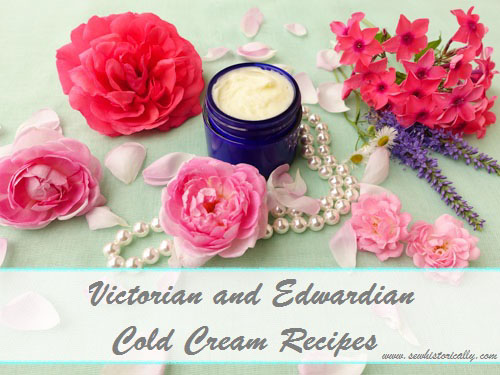
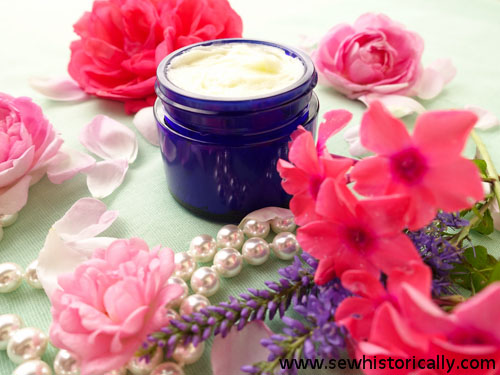
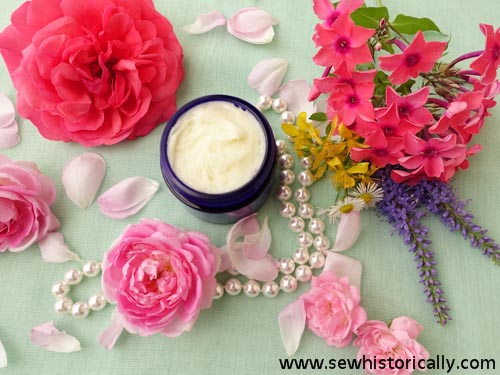

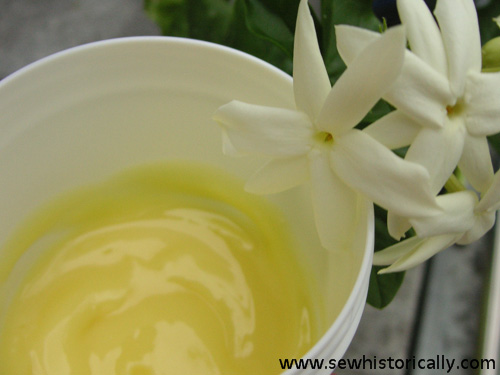
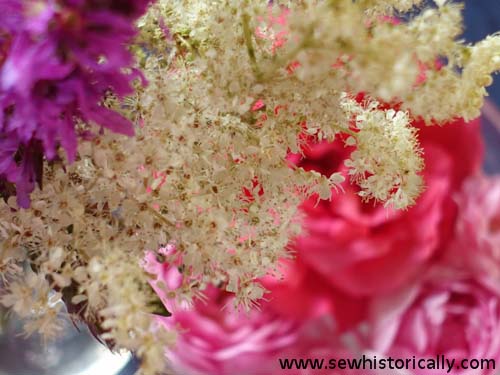
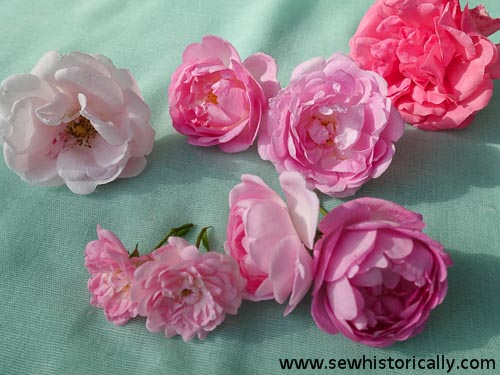
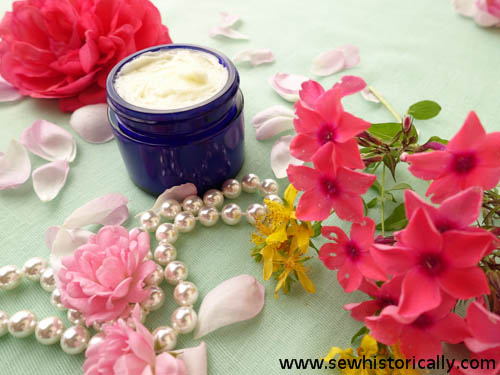

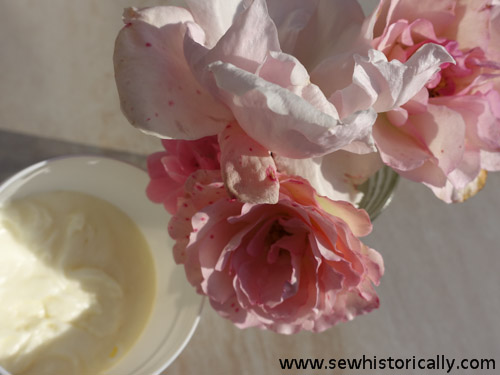
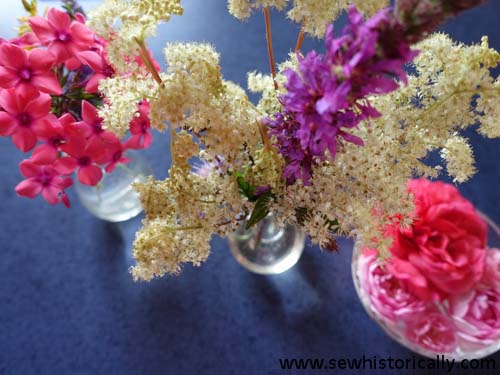
I must try and make some of these creams Lina thank you for the recipes
I now always make my own hand and face cream with beeswax, almond oil and rosewater. It’s so much more nourishing than store-bought creams.
This post is both fascinating and beautiful. I smiled when I saw the one for skin bleaching. How times have changed.
Times have certainly changed! 😉 I tried out an Edwardian cucumber moisturizer – ‘a bleaching cream after vacations at the seashore or in the mountains’ – and it fortunately didn’t bleach my skin! 😉
Lina I am still washing too many dishes here in the 21st Century. I could use some of these creams to protect my hands.
Let me know how you find them if you try them out! 🙂
Allergic to rose water. oil. Will creams do well without?
Rexall’s Theatrical Cold Cream worked perfect for my dry, sensitive skin, but no longer being made. Does someone know the ingredients, so that I could make it myself?
You could use orange flower water, witch hazel water or simply boiled water instead. I’ve all three used in homemade cold cream and it works really well.
Hi, I noticed some errors in your transcription of the cold cream with olive oil and glycerin recipe. Here, it says 1 oz of olive oil, whereas the original book has 4 oz. In addition, I believe the 2 dr. glycerin is not 2 drops but 2 drachms.
(unfortunately, I only noticed these things *after* I made up a small batch according to how you wrote the recipe lol. No matter, I’m sure I’ll find a use for this – if nothing else, it should work beautifully as shoe cream ?)
Thanks, I corrected it. By the way, you can also gently re-heat the cold cream and add more olive oil. 🙂
Hi! I would like very much to go on an adventure and try making a Victorian cold cream myself! It also looks like it’s MOSTLY the Edwardian recipes that call for spermaceti, so choosing an older recipe might mean I won’t have to start substituting ingredients?
These recipes also don’t mention how much cream you’ll end up with. I would very much like to just make one little jar for myself, at least at first. Is it more difficult, do you think, to make tiny batches? Because I don’t mind making larger batches once I’ve got the hang of it – that stuff can be excellent Christmas presents for the whole family, if I just use boiled water instead of any scent! However, I should very much like to not waste a large amount of ingredients if I should….well, fuck it up. The last time I did anything chemistry-related that wasn’t dyeing wool in woad baths, is in high school, and… that was half a lifetime ago lol
I also wonder if there is any PRACTICAL difference between yellow and white wax? All of these recipes call for white wax, but when I Google white wax, the only explanations I find, say that white wax is yellow beeswax that has been bleached/purified/filtered/processed to give it a white colour.
So I was wondering if one can use ordinary, yellow beeswax for these recipes? Is there a reason for the choice of white, except to give the cream an appealing, white colour?
I wish to make my own cold cream, because I had one from…. Enchanted Living, I think they’re called, and I LOVED it – however, it contained lard, which a) means I can’t gift it to my muslim friends, and b) it became rancid before I had used even half of it.
Thank you in advance, for your answers!
Sincerely,
Nene
Hi! Victorian recipes often contained butter or lard instead of spermaceti. You probably don’t want to use that either! 😉 And yes, white wax is just bleached yellow beeswax: it was solely used for the color. But cold creams with (yellow) beeswax also turn out almost white. 😉 I always use organic (yellow) beeswax. After trying different historical cold cream recipes, this Edwardian recipe is my favorite: I adapted the recipe so it just makes a small batch. 🙂